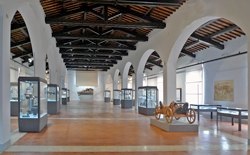
This room in the loft of San Domenico Vecccio was used as a dormitory by the friars, and had a staircase that led directly to the choir below. It became known as the Sala dei Bronzi when the Bronze Age Collection of the museum was exhibited here. It has now been restored and houses a collection of ancient artefacts from the cities of Umbria.
The exhibits in this room that came from the following locations have their own pages in this site:
The description below pre-dates a re-organisation of this room: some of the exhibits were not exhibited here during my visit in June 2017.
Amelia
Grave goods (7th - 2nd centuries BC)
A necropolis was discovered in 2001 during the demolition of the Consorzio Agraria (agricultural co-operative) on Via Rimembranze, just outside Amelia. (Fragments of the celebrated statue of Germanicus and other Roman remains had been found here in 1963). when stood. Most of the tombs had been violated, but the remaining grave goods, many of which are of high quality, showed it to have been in use over a long period. These grave goods include painted Faliscan pottery, jewellery (much of it gold) and a number of bronze objects, including mirrors.
Three objects in showcase 16 , all of which date to the 4th or 3rd century BC, are particularly eye-catching:
-
✴a patera (a shallow dish used for drinking, usually in a ritual context) with a red-figure design of a satyr holding a drum, which is attributed to the so-called Fluid Group of vase painters (ca. 320 BC);
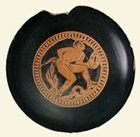
-
✴a small, cylindrical "cista" (a container for sacred objects) with a lid decorated with a figure of a cow (to the right in this photograph); and

-
✴an askos (vase or other container for liquid) in the form of a kneeling doe (to the left in this photograph).
Other grave goods from the necropolis are displayed in the Museo Archeologico di Amelia.
Bettona
Grave goods from the Ipogeo di Colle (3rd – 1st centuries BC)
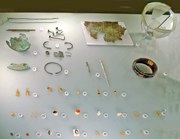
These grave goods in showcase 20 were retrieved when the Ipogeo di Colle, small barrel-vaulted tomb, was discovered by chance in the mid-19th century during the construction of the new road from Perugia to Bettona. It was excavated in 1913, by which time its barrel-vaulted ceiling had collapsed.
The tomb had already been robbed in ancient times, but some funerary urns and their grave goods were discovered during the excavations of 1913. The grave goods were moved from Bettona to the Villa Giulia, Rome in the 1930s. They were returned to Umbria in 1975, at which point some were lost. Those that survive include:
-
✴many pieces of gold jewelry;

-
✴fragments from a glass dish (2nd century BC) that was probably from the Middle East;
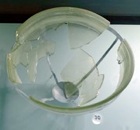
-
✴coins from the Republican era; and
-
✴a funerary inscription (late 2nd century BC) in archaic Latin punched on a bronze sheet, which commemorates

-
[-] UOISIUS L F [...]
-
AUIANIA[...]
-
[?] Voisius, son of Lucius and Aviania.
-
The name seems to retain the Etruscan formula, in which Avania’s name is apparently not preceded by the Latin “gnatus” (born of). The inscription is described in context in the page on Early Latin inscriptions.
Bevagna
Finds from Viale Properzio (7th – early 6th century BC)
Showcase 15 contains finds from an archaic settlement that was excavated near the junction of Viale Properzio and Via 1 Maggio (see Walk II, Bevagna) in 1980-2. They include:
-
✴an architectural decoration in the form of a gargoyle with the shape of a cat’s head;
-
✴a number of impasto and bucchero pottery fragments; and
-
✴a loom weight.
Antefix (4th century BC)
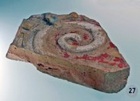
Sundial (ca. 100 BC)
This limestone sundial was ploughed up in 1969 near the tabernacle of the Madonna del Core, outside Porta Cannara (see Walk II, Detour B, Bevagna). The Umbrian inscription on the sundial (which is also described in the page on Umbrian Inscriptions after 295BC) uses an Etruscan alphabet:
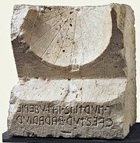
cvestur farariur
[-] P. Nurtins [and] Ia. T. Uferier,
the quaestores of spelt [donated]
The surname of the first magistrate derives from the name of the Etruscan goddess, Nortia. The second transcribes into Latin as Iantus Aufidius, son of Titus. Their magistracy is probably analogous to that of “the two men who come to fetch the flour” for the sacrifice at the annual ritual described in Table Vb of the Iguvine Tables.
Cesi
Grave Goods ( 9th - 6th centuries BC)
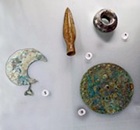
Votive bronzes (5th century BC)
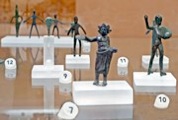
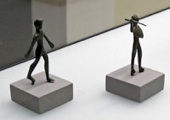
These votive bronze warriors in showcase 23 were discovered in 1988 on the site of an Umbrian sanctuary on Monte Torre Maggiore, near Cesi. Other votive objects from the site are exhibited in the Museo Archeologico, Terni.
Città di Castello
Finds from Riosecco (8th-6th centuries BC)
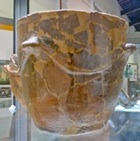
-
✴impasto vessels (8th century BC) with garland-shaped handles, including the one illustrated here;
-
✴an impasto lid (ca. 600 BC) with a tall decorated handle;
-
✴a comb-shaped bronze pendant (6th century BC); and
-
✴a bone needle.
Finds from Lerchi (late 8th century BC)
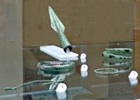
-
✴a fibula with an arched bow and quadrangular cross section, originally covered with amber and bone;
-
✴three bracelets;
-
✴a small chain made of multiple rows of interweaved rings;
-
✴a distaff; and
-
✴a lance-head and shaft.
Civitella d’ Arna
Antefix (4th century BC)
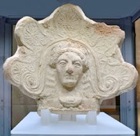
Colfiorito di Foligno
Finds from the Necropolis
These grave goods are exhibited in showcases 13-14.
Grave goods (8th and 7th centuries BC)
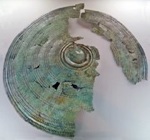

These bronze grave goods, which were found in the 19th century, came from some of the earliest tombs in from the necropolis at Colfiorito. They belong to the Belluci Collection.
Grave goods (5th century BC)
These grave goods from an inhumation tomb (Tomb 8) of the necropolis at Colfiorito include:
-
✴an impasto funerary vase with a figure of a man and his horse on the lid; and
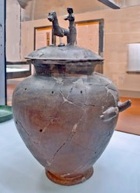
-
✴a bronze bracelet and glass beads.

Sanctuary of Cupra
Excavations carried out in 1962-7 on a site some 200 meters north of the church of Santa Maria di Plestia outside Colfiorito revealed the existence of an important extra-urban sanctuary that was in use from the 6th century BC until the Roman conquest.
The sanctuary was monumentalised after the Roman conquest, when the municipium of Plestia was established nearby. The sanctuary continued to be used by the Romanised population until the late Republican period.
Bronze plaques (4th century BC)

cupr]as, matres pletinas sacru esu
Museo Archeologico Nazionale di Umbria (MANU), Perugia


cupr [ cupr]as, matresp[letinas
MANU, Perugia MAC, Colfiorito
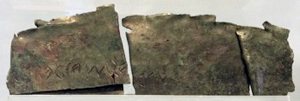
cupras, matres pletinas sacru
Museo Archeologico di Colfiorito (MAC), Colfiorito
The most important finds from the site were four fragmentary inscriptions relating to the presiding deity, Cupra:
-
✴two of these are exhibited in showcase 24 here; and
-
✴the other two are in the Museo Archeologico Colfiorito;
are inscribed in the Umbrian language using an Etruscan alphabet that shows the influence of Volsinii (Orvieto). None of the inscriptions is complete, but they can be reconstructed to read:
cupras, matres pletinas, sacru esu
I am a sacred to Cupra, mother of the Plestini
All four are illustrated on the site of the Associazione Culturale Istituto di Ricerche e Documentazione sugli Antichi Umbri, Gubbio. The inscriptions are discussed in their wider context in the page on Umbrian Inscriptions before the Roman Conquest and on Umbrian Religion.
The goddess Cupra is also known from an inscription from Fossato di Vico (below).
Other Finds from the Sanctuary of Cupra
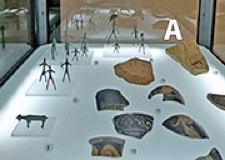
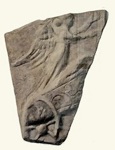
Relief A
These objects in showcase 24 include:
-
✴bronze votive offerings (6th - 5th centuries BC);
-
✴ceramic fragments (4th century BC);
-
✴two architectural reliefs (2nd centuries) that would have decorated the exterior of the sanctuary. The relief I have marked ‘A” is one of a number that depict chariot scenes, which date to the middle of the 2nd century BC.
Similar objects from both phases of use of the sanctuary are exhibited in the Museo Archeologico Colfiorito and in the Museo Archeologico, Palazzo Trinci.
Gualdo Tadino (Fossato di Vico)
Votive bronze (5th century BC)
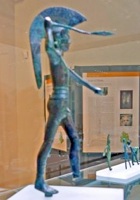

This votive bronze warrior in showcase 24 (shown here in two views) was discovered in Fossato di Vico.
Inscribed bronze plaque (2nd century BC)
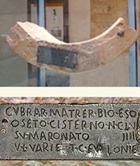
CVBRAR MATRER BIO ESO
OSETO CISTERNO N(ummi) CLV
IIII SV MARONATO
V L VARIE T C FVLONIE
Simone Sisani (referenced below, 2007, at p. 400, entry 96) dated it to the late 3rd century BC, but Giulio Giannecchini (in L. Agostiniani et al., referenced below, p. 51, entry 35) more recently dated it to the second half of the 2nd century BC.
Simone Sisani (referenced below, 2009, pp. 204-5, entry 26) observed that the inscription conveys two distinct pieces of information:
-
✴the first line can be translated as:
-
“this [is] the ‘bia’ [probably a fountain] of [the goddess] Cupra Mater”; and
-
✴the last three lines record that:
-
“[this] cistern was built at a cost of 159 nummi in the maronate (magistracy) of
-
•Vibius Varius, son of Lucius; and
-
•Titus Fullonius, son of Gaius.
Sisani suggested that:
-
✴the terracotta support to which the plaque is still fixed probably came from the rim of a round puteal that covered the opening of the cistern through which water was drawn; and
-
✴the cistern had been used to store water that had taken from the fountain of Cupra Mater, which was therefore sacred to the goddess.
In an earlier publication, Simoni Sisani (referenced below, 2007, at p. 400) reasonably suggested that the marones named in it been magistrates of nearby Tadinum, to which Helvillum had almost certainly belonged.
The goddess Cupra Mater is also known from four inscriptions (4th century BC) from a sanctuary that was excavated at Plestia (above). It also seems that she had a sanctuary at Helvillum: Francesco Marcattili (referenced below, at pp. 478-80 and Figure 16) described excavations that were carried out in 1918 on a site adjacent to the find spot of the inscription, which revealed a rectangular sanctuary containing two large water basins. On the basis of his analysis of cult sites in Italy dedicated to Bona Dea, with whom the Umbrian Cupra has been identified, he observed that:
-
“[The fact] that the cult celebrated in the sanctuary of Cupra of Helvillum vicus was identical to that officiated for Bona Dea in Ostia (and elsewhere) is revealed without a shadow of doubt by the existence of two large open basins ... in the immediate vicinity of the [find spot of the inscription]. ... As is evident, we have here a coherent structural and functional system that satisfies the liturgical requirements ... that were common to the worship of both Bona Dea and Cupra” (my translation).
In other words, the bia at Aja della Croce seems to have been integral to a sanctuary dedicated to Cupra.
This inscription is also described in the pages on Umbrian Inscriptions after 295BC, Umbrian Government and Umbrian Religion. It is is described in entry 35 of the catalogue edited by L. Agostiniani (referenced below).
Gubbio
Column Krater (425-400 BC)
This red-figured column krater (vase with column-like handles) is exhibited as number 11 in showcase 6. It came from one of ten graves (5th century BC) that were excavated in 1989 in Via Gandhi (see Walk II), at the north west edge of the Vittorina necropolis. (Another four vases from other graves uncovered in these excavations are exhibited in the Antiquarium, Gubbio).
The main scene on the vase exhibited here (inv. 117219) depicts a woman playing a double flute between dancers, in a scene that probably formed part of a symposium. The invitees at such events were only men, so the women here probably represent prostitutes who were paid to entertain the guests. On the back, three young men wearing cloaks and carrying sticks seem to be dancing.
Norcia
Votive statues from Ancarano di Norcia (5th - 3rd centuries BC)
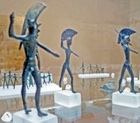
A small bronze figure (4th century BC) of a reclining man that was also found during these excavations is now in the British Museum, London.
Otricoli
Figure of a man (2nd century BC)
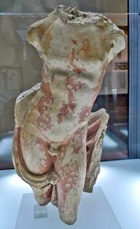
Spello
Antefix (2nd century BC)

Terni
Grave goods from Acciaierie Necropolis (9th century BC)
This necropolis was discovered in 1884 during the construction of the Acciaierie di Terni (steelworks) to the east of the city. Some 200 tombs were found here: cremation was sometimes used in the earliest period (10th century BC), but most of of the tombs came from a slightly later period and were in the form of ditch burials within stone circles. Some of them clearly belonged to a rich warrior class, whose men were buried with their weapons.

Other grave goods from the necropolis are exhibited in the Museo Archeologico, Terni and the Museo Nazionale Etrusco di Villa Giulia.
Grave goods from San Pietro in Campo Necropolis (ca. 600 BC)
The demolition of the Poligrafico Alterocca in 1996 provided an opportunity for the excavation of the northern part of this necropolis, which led to the discovery of a further 46 tombs. The grave goods exhibited here [which showcase ?] came from Tomb II and include:
-
✴a number of impasto funerary vases; and
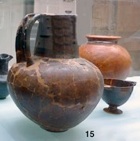
-
✴a bronze dish [with pearls around its rim?].
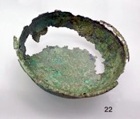
Todi
These exhibits are in showcases 17-19.
Antefix (4th century BC)
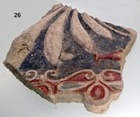
Grave goods (ca. 200 BC)
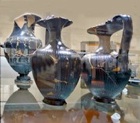
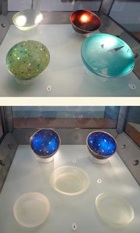
Read more:
F. Marcattili , “Tra Venere, Bona Dea e Cupra: Note a Margine della Lamina di Fossato di Vico”, in:
A. Ancillotti et al. (Eds), “Forme e Strutture Della Religione nell' Italia Mediana Antica: Atti Del Terzo Convegno Internazionale Di Studi Umbri: 21-25 Settembre 2011”, (2016) Rome
L. Agostiniani et al. (Eds), “Screhto Est: Lingua e Scrittura degli Antichi Umbri”, (2011) Città di Castello
S. Sisani, “Umbrorum Gens Antiquissima Italiae: Studi sulla Società e le Istituzioni dell' Umbria Preromana”, (2009) Perugia
S. Sisani, “Fenomenologia della Conquista: La Romanizzazione dell' Umbria tra il IV sec. a. C. e la Guerra Sociale”, (2007) Rome
Continue ahead on leaving the Sala dei Bronzi and turn right into the room that
I have designated Etruscan Perusia I.
Return to the main page on the Museo Archeologico



